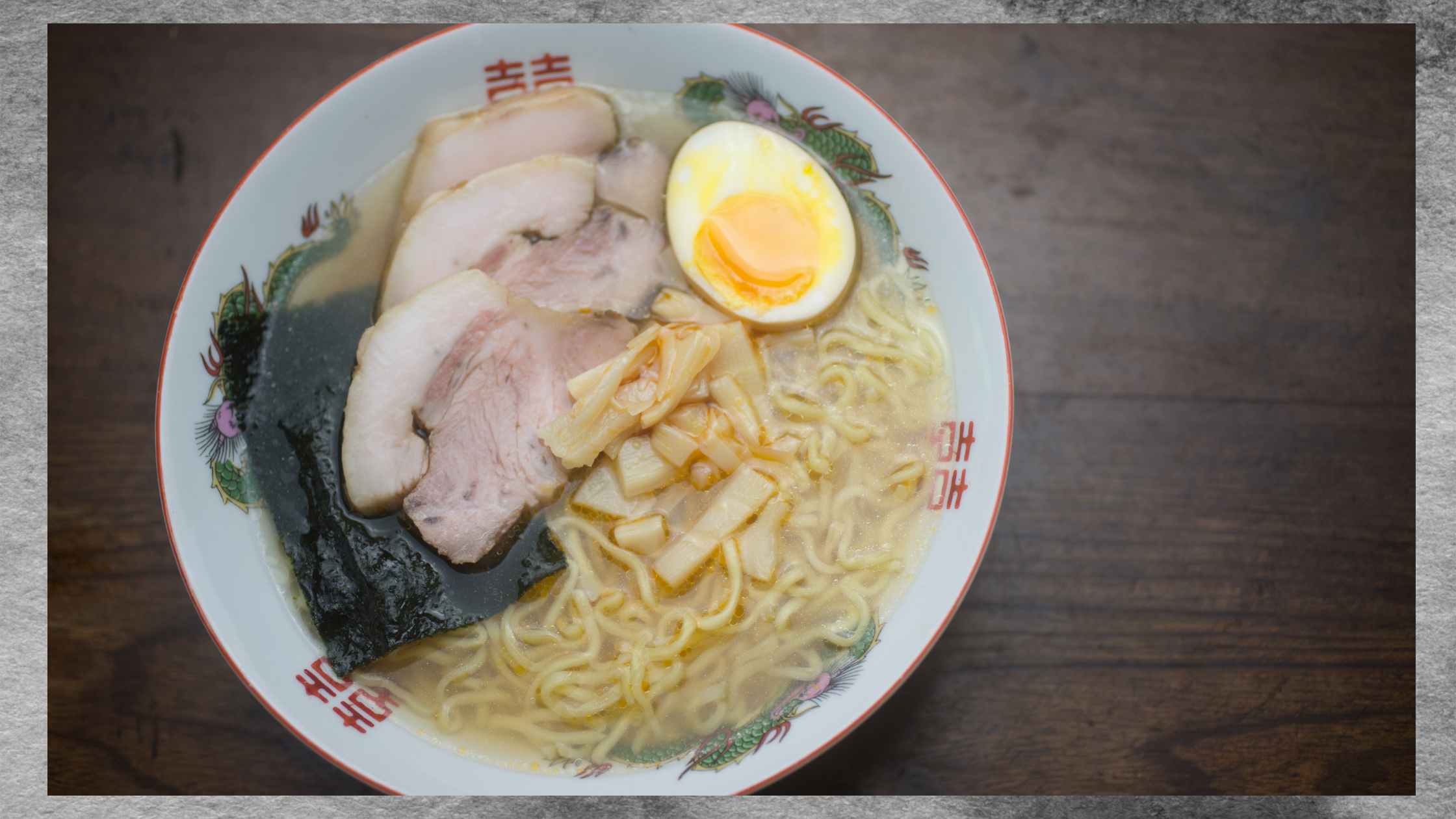What do you think of when it comes to ramen noodles? Maybe a “brick” of noodles, wrapped in a plastic package, with a packet of flavoring?
That’s instant ramen. It’s been around since 1958. But there’s a lot more to the story behind ramen noodles.
What is Ramen?
Ramen, the literal translation, is “pulled noodle.”
The origins of ramen are obscured in history.
One thought, a legend really, is the dish being introduced to Japan from China through a refugee escaping Manchu rule in China during the 1660’s.
A more likely story about ramen is it was introduced to Japan through Chinese immigrants and merchants.
A group of these guys went to Yokohama, Japan in the late 1800’s and set up a noodle shop.
They sold a dish called shina soba. This is what would become the ramen noodles we know today.
The noodle style definitely originated in China.
They made a wheat noodle, like a pasta. Simple ingredients: flour, salt, water, and kansui. That’s the “secret ingredient” for what makes them look and taste a little different than other noodles.
Kansui is an alkaline water. That means that the water has more minerals in it than, say, tap water.
This water was originally found in Mongolia. The Chinese found that it gave a good texture to the noodles and they made it a staple in the ingredients.
What about the pulled noodle part?

That’s how the noodles were made! They were stretched from a ball of dough, by hand.
The dish served in Yokohama combined the hand-pulled noodle, used in a Chinese dish called La Mian, with broth and pork medallions.
The dough for the noodles is prepared, then the cooks pull the dough and make one really long noodle at a time!

Then the super long noodle is dropped into the broth to cook.
Long, skinny, fresh noodles don’t take very long to cook. It ended up being a pretty popular way to have a bite to eat.
Little shops and food stalls began popping up all over Japan, serving up the dish to hungry workers.
Why is the Dish Called “Ramen”?
During the boom of noodle shops, there was a particular chef who would exclaim “Hao le!” when he was done cooking a dish. He was announcing that the yummy stuff was ready!
That le sounded kind of like ra to the native Japanese speakers. Pretty soon, they combined that ra with men, which is Japanese for noodle… the rest is history! The name stuck.
The Rise of the Instant Noodle

In 1958, a man named Momofuku Ando put together a new kind of product.
While cooking fresh noodles doesn’t take long at all, making the noodles was pretty time consuming. He wanted to make something that worked better for the people.
He pre-cooked the noodles and then dried them into brick-shapes. He wrapped up those little bricks of noodles and added a packet of bullion. Ta Da! Instant ramen was born!
The funny thing about it, instant ramen noodles were more expensive than buying fresh udon noodles.
They were considered a luxury! Now? You could live on ramen noodles, and add some of your own topping creations, for less than $10 a week!
What was the first flavor of instant noodles? Chicken! Japan now has dozens of varieties of instant noodles.
Ramen Cuisine
Ramen innovations didn’t stop at instant noodles.
Restaurants dedicated to ramen noodle dishes began popping up all over Japan. Ramen, already a big part of the culture of Japanese food, became gourmet food.
People began adding all sorts of stuff to the broth-noodle dish. Scallions, seaweed (nori,) dried fish or scallops, spring onions, pickled ginger, eggs… the possibilities of additions are unlimited.
Chefs of the ramen restaurants began experimenting with the broth flavors. Chicken, pork, and soy are the primary flavors even now.
Different regions in Japan discovered their favorites.

Sapporo, in the north, favors a miso ramen.
You’ll find toppings like sweet corn, garlic, and bean sprouts. Seafoods like squid and crab are popular. And even just a simple broth and noodle combo, topped with butter!

In the southern half of Japan, Fukuoka has a Hakata-style ramen dish.

Where many ramen broths are clear, the Hakata ramen broth is cloudy. Made from soy sauce and pork bones, it’s simmered for hours. That’s where the cloudy color comes from. The broth is called tonkotsu.

There is also shoyu ramen. Shoyu is Japanese for soy sauce. Soy sauce is a popular ingredient in Japanese cooking, and this combination was a natural! One of the first kinds of ramen, it’s still going strong on the “favorites” list.

Then there is shio ramen. Shio means salt in Japanese. It’s a light ramen with a clear broth. The broth is made with chicken bones and flavorings like dried sardines or bonito flakes.
Ramen is a comfort food in Japan. There are dozens of ways to top it. Different ways to make the broth. And no matter what your favorite flavors are, you can find a ramen that fits it!
Ramen fun facts:
A package of ramen noodles contains about 51 meters worth of noodles. If you lay them out end to end, they would stretch about the length of 2 tennis courts!
Osaka, Japan has the only museum dedicated to the history of ramen.
Instant ramen noodles were taken to space! In 2005, Japanese astronaut, Soichi Noguchi took instant ramen on his space flight. They were also the first ever noodles eaten in space! Ando created a special package of instant ramen just for zero gravity dining.
Ramen noodles, especially the instant variety, are used in all sorts of recipes now. Not just for soup, they’re added to salads and used in place of Italian pasta. There are even some desert recipes that use them.
You can enjoy all the tastes of ramen to find your favorite. While you're exploring this delightful Asian cuisine, check out our Japan box for even more culinary adventures!







